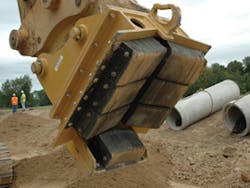Project Profile: A Faster Pipe Installation in Michigan
A common challenge to contractors who install concrete pipe is homing it properly, without damaging the barrel or chipping the bell and spigot. Although concrete pipe installation manuals detail the industry’s best practice for homing pipe, contractors do the best they can to install according to standards and best practices within the context of challenging site conditions, schedules, and budgets. It is not uncommon for installers to use the best available equipment and procedures to home pipe but still not achieve the best connection and grade accuracy.
However, installation of concrete pipe has become easier for contractors in Ingham County, MI, with a new homing device called an E/Z Set pipe tool. The device does not require contractors to completely remove a pipe, correct the grading, and then reinstall it, but instead allows the installer to reset the pipe and move it into place without damage. The device can be transferred to various excavators and used for installing a wide range of diameters of concrete pipe because of its angular configuration.
In Ingham County, concrete pipe is the product of choice for storm and sanitary sewers because of its durability, sustainability, and compatibility with the environment. Contractors working in the county are fully aware that officials strictly enforce ASTM C1479-01 (Practice for Installation of Precast Concrete Sewer, Storm Drain, and Culvert Pipe Using Standard Installations). Full-time inspection is required, along with post-installation video review, before each pipeline is accepted. In addition, ASTM 1479 states, “Making adjustments in grade by exerting force on the barrel of the pipe with excavating equipment, by lifting and dropping the pipe, or by lifting the pipe and packing bedding material under it shall be prohibited. If the installed pipe section is not on grade, the pipe section shall be completely unjoined, the grade corrected, and the pipe then rejoined.”
The E/Z Set pipe tool, developed by Pat Fitzsimons of Teri’s Excavating Inc., was designed to eliminate cracking and chipping and to provide an alternative to the old method of homing by pressing down on the bell of the pipe with the bucket of an excavator. Cracking and chipping is avoided with rubber blocks attached at the end of the device.
The Dunckel Road Extension was the first project on which the device was used. Located in Lansing, MI, the project is designed to improve access to a medical/industrial area. The project had approximately 2,600 feet of concrete pipe, along with multiple sizes of manholes and catch basins. Ninety percent of the pipe was installed under the new roadway, with the balance under the construction right of way at depths ranging from 8 to 12 feet. Fitzsimons realized how time consuming and costly removing pipe and starting over would be, so he created the device, which allowed the installation crew to correctly home the pipe without jeopardizing its quality.
“Where many contractors complain repeatedly about this procedure, Pat [Fitzsimons] made lemonade out of lemons!” says Al Boyer of Leedy Design Group. “That is, he looked for a solution and found one.”
Fitzsimons says that the device not only provides a safer alternative to using an excavator bucket but also increases production time. The device can be attached to an excavator in as little as 30 seconds and can home the pipe in much less time than the 15 to 30 minutes it would take to lift the pipe, excavate, and relay it.
With the E/Z Set pipe tool, Teri’s Excavating was able to double production on the project. Inspectors on the job said the tool was amazing. It removed the concern of chipping, which has been a hot topic for the last five or six years. Dave Love of Ingham County Drain Commission says, “I feel that in the future when contractors say they are going to use this device, inspectors and drain commissioners will feel relieved, because the concern of chipping the pipe with the bucket is gone. It’s definitely a huge benefit for concrete pipe.”
In addition to improving the quality of the installation, the E/Z Set pipe tool reduced inspector/contractor disagreements and enhanced the working relationship between the owner and contractor.


